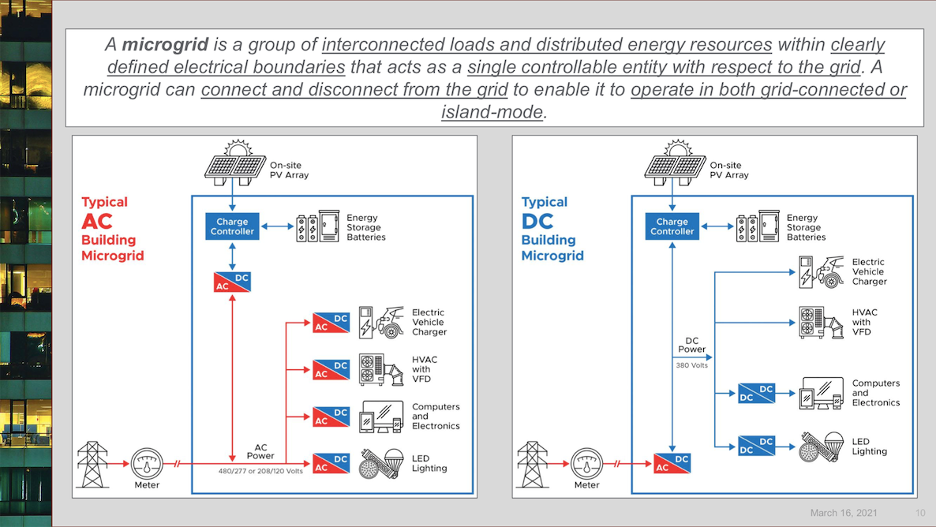On March 16-17th, LEDucation hosted a virtual conference about various subjects in the lighting industry. They kicked off the event with the webinar “DC and PoE Lighting: Opportunities and Benefits” on March 16th. The webinar featured speaker Gabe Arnold of Pacific Northwest National Laboratory (PNNL). The data presented in the webinar was based off of market research done by PNNL.
The discussion started off with the differences between AC and DC lighting. The infrastructure in the United States is based off of AC, while LED drivers and many other components convert AC to DC. This is an inefficient process as there is a 5-10% loss of energy with each conversion of AC to DC, requires additional equipment, and introduces a failure point. If a power grid implements many conversion points of AC to DC (see figure 1), there is a lot of energy loss which is costly but most importantly unsustainable. This is one of the arguments in favor of DC infrastructure.

The topic turned to the discussion of microgrids (see figure 1 for definition). Microgrids possess many benefits:
- Could protect against rolling blackouts like the ones seen in Texas during the winter
- Increase value proposition for renewable energy
- Clean renewable power will be available at any time
- Help buildings achieve zero carbon emissions
Gabe Arnold said we should expect to see more rolling blackouts due to bad weather caused by climate change. The takeaway is the current electrical infrastructure is not sufficient for our current climate.

The next topic focused on the benefits that entities in the industry think are associated with DC and PoE lighting (figure 2), followed by an assessment of the validity of these claims in order to paint a more clear and truthful image of DC and PoE lighting.
- Claim: Reduced installation costs due to not needing to hire licensed electricians due to lower voltages of DC needed to supply to drivers.
- Validity: Not valid. Many states and counties still require licensed electricians to install lighting in buildings even at lower voltages.
- Claim: Reduced costs by eliminating extra hardware needed to convert AC to DC.
- Validity: Valid. Eliminating extra hardware lowers manufacturing costs and contributes to sustainability.
- Claim: DC is more efficient than AC.
- Validity: Partially. DC isn’t inherently more efficient, it’s only more efficient within the context of eliminating AC to DC conversion points.
- Claim: DC is more reliable.
- Validity: Valid. DC can be more reliable.
- Claim: Reduced components and carbon footprint.
- Validity: Valid. AC/DC conversion parts can take up 40% of the driver, eliminating these components leads to a smaller, simpler, and more reliable driver by eliminating failure points, as the AC/DC conversion components are the part of the driver most likely to fail.
It’s apparent that DC and PoE lighting have many benefits, so you may be wondering why hasn’t it caught on? There are a few reasons as to why:
- Status quo. We are used to using AC and implementing conversion points.
- Switching from AC to DC is not as simple as switching from fluorescent to LED. There will need to be a significant infrastructural overhaul in the forms of wiring, codes, and protocols.
- Lack of awareness.
LEDucation is helping with the lack of awareness by hosting this educational webinar. Perhaps we will see more DC and PoE lighting as their benefits become more known amongst the industry. It is possible we’ll see developments in DC and PoE lighting due to many companies in the industry focusing on sustainability and desire to have a zero-carbon footprint. Be on the lookout for more of our articles that cover LEDucation.



